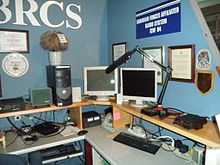Canadian Forces Affiliate Radio System
The Canadian Forces Affiliate Radio System was established on August 8, 1946, initially under the auspices of the Royal Canadian Air Force, as a means both of facilitating communications during emergencies or contingencies and assisting Canadian service personnel deployed overseas to communicate with family at home. The programme, partially integrated with the Civil Defence Communications Organization on August 31, 1952, enlists amateur radio volunteer operators and equipment but uses neither standard radioamateur frequencies nor callsigns as CFARS is allocated its own specific official frequencies and identifiers.[1]
During the Cold War, Canadian troops deployed CFARS radio to military outposts in West Germany.[2] In the 1991 Gulf War, CFARS provided a means for Canadian soldiers stationed in Qatar to call home, boosting morale.[3] On October 6, 2011, a malfunction of Telesat's Anik F2 satellite disrupted communications to Canada's high Arctic region for several hours;[4] CFARS operators were called upon to provide emergency backup communication.
CFARS consists of a mix of military stations (publicly owned and operated by DND personnel), military unit/club amateur radio stations (operated and maintained on military sites by volunteer radio amateurs) and individual affiliate radio stations (which are privately owned and operated by individual radio amateurs affiliated with CFARS). Historically, CFARS stations have also been deployed on Canadian Coast Guard vessels for use during search and rescue deployments.[2]
Agencies actively served by CFARS include the military, Public Safety Canada, Transport Canada and the Royal Canadian Mounted Police.[5]
A counterpart to CFARS exists in the United States of America as the Military Auxiliary Radio System; established procedure is designed to facilitate interoperation between the two systems. While the use of CFARS phone patch traffic in its traditional rôle as a means for soldiers to contact loved ones is declining with the growing access to communications satellites by military units in the field, the amount of digital radio traffic (such as electronic mail) carried has been increasing.
A working Canadian Forces Affiliate Radio System station is on exhibit as part of the Military Communications and Electronics Museum at CFB Kingston in Kingston, Ontario.
Frequencies

The following frequencies are in use by the Canadian Forces Affiliate Radio System (CFARS) worldwide:[6]
| 6978 kHz | Alpha |
| 14386 kHz | Bravo |
| 14460 kHz | Charlie |
| 14463 kHz | Delta |
| 14446 kHz | Echo |
| 20971 kHz | Foxtrot |
| 20963 kHz | Golf |
| 29715 kHz | Hotel |
| 14454 kHz | Juliet |
| 14449 kHz | Kilo |
| 20977 kHz | Lima |
| 13954 kHz | Mike |
| 6982 kHz | Whiskey |
| 6962 kHz | Xray |
| 4052 kHz | Yankee |
| 4023 kHz | Zulu |
See also
- Military Auxiliary Radio System
- MARS / CAP
- Amateur Radio Emergency Service and Amateur Radio Emergency Communications
References
- ↑ Major D.J.W. Bergeron (December 2011). "CFARS: Why Should I Become Aware and Consider Being A Member". Communications and Electronics Branch newsletter (Canadian Department of National Defence) (Volume 56). Retrieved 2012-05-15.
- ↑ 2.0 2.1 Robert S. Ing (1992). The Canadian Military Radio Frequency Guide : 50 KHz. - 500 MHz. p. 12. ISBN 9781895377064. Retrieved 2012-05-15.
- ↑ Michael Hanlon (Jan 2, 1991). "Callers order flowers for families at home. Canadians stay in touch by radio phone". Toronto Star. p. A2.
- ↑ "Satellite problems ground Nunavut flights". Canadian Broadcasting Corporation. 2011-10-07. Retrieved 2012-05-15.
- ↑ Les Lindstrom (December 2010). "CFARS – Alive and Well!" 54. Communication & Electronics Branch newsletter, Canadian Forces.
- ↑ Larry Van Horn, N5FPW. "Monitoring Times Hot 1000 HF Frequencies". Monitoring Times (magazine).
External links
| Wikimedia Commons has media related to Canadian Forces Affiliate Radio System. |